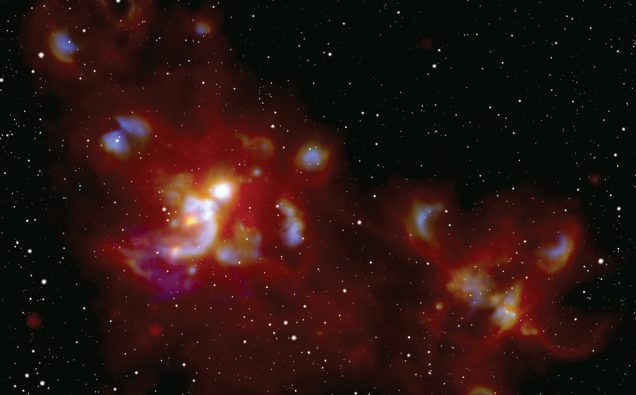
An image of a cosmic light show sparked by the formation of massive stars Credit: NASA/SOFIA/Lim and De Buizer et al. and Sloan Digital Sky Survey
Researchers and space scientists are excited that a team has been able to peer into a giant celestial cloud to learn about star formation that takes place thousands of light years away from our planet.
Star formation has been a mystery for as long as humans have been gazing into the sky with wonder and awe and fiction writers and poets have been musing about milky ways and galaxies.
A team of researchers at SOFIA, the Stratospheric Observatory for Infrared Astronomy, used an airborne telescope and sensitive infrared camera, to peer inside the dense cloud.
“They captured a cosmic light show sparked by the forming stars, including many that have never been seen before,” NASA reported Friday.
According to the space agency, when massive stars — many times larger than our Sun— are born, they shine hot and bright before eventually exploding as supernovas.
The forming starts release so much energy that they can affect the evolution of galaxies.
But, unlike stars like the Sun, astronomers know much less about how these enormous stars form.
“Massive stars like this represent less than one percent of all stars, but they can affect the formation of their stellar siblings,” sJim De Buizer, Universities Space Research Association senior scientist at the SOFIA Science Center, says.
“Stars like our Sun have much quieter and humbler origins, and because there are so many of them, we understand their birth properties more thoroughly.”
The giant celestial cloud that the team peered into is called W51 and is distantly located, almost 17,000 light years away.
Made mostly of hydrogen, it’s a place where rare, gigantic stars are forming.
But they are born deep inside the cloud, invisible to the light our eyes can see.
But making use of the infrared camera – called Faint Object infraRed CAmera for the SOFIA Telescope, or FORCAST that has sensitive detectors and powerful magnification – enabled the researchers to discover the enormous stars right after their birth.
NASA says knowing about how massive stars form in our Milky Way Galaxy helps scientists understand how these stars form in distant galaxies that are too far away to see in detail.
“This is the best resolution currently available using these wavelengths of infrared light,” Wanggi Lim, Universities Space Research Association scientist at the SOFIA Science Center, says.
“Not only does this reveal areas that we could not see before, but it’s critical to understanding the physical properties and relative age of the stars and their parental clouds.”
“Researchers combined the SOFIA data with data from NASA’s Spitzer Space Telescope and Herschel Space Observatory to analyze the stars. They found that while they are all young, some are more evolved, and others are the youngest, most recently-created stars in the cloud.
“One may be exceptionally large — estimated to have the equivalent mass of 100 Suns. If future observations confirm it is indeed a single, colossal star, rather than multiple stellar siblings clustered together, it would be one of the most massive forming stars in our galaxy,” the space agency said.

















